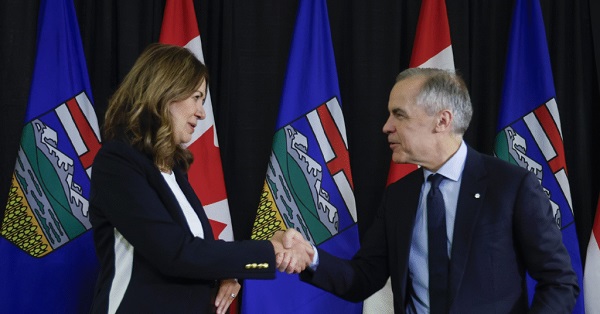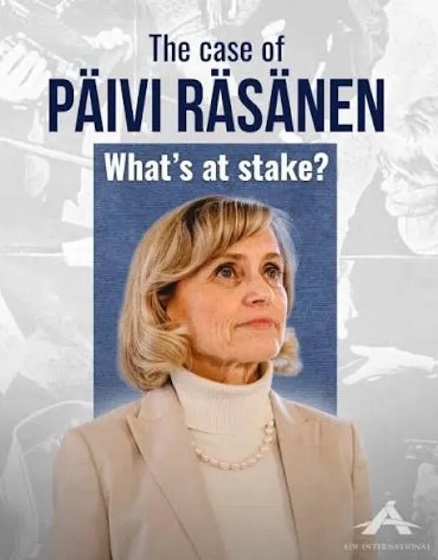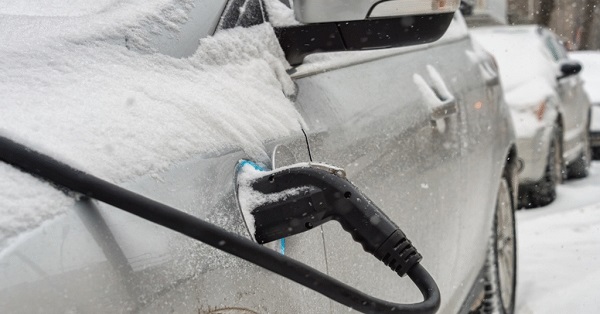Alberta
Investigation reveals terrifying life and death situation faced by police officer forced to shoot attacking suspect

Figure 1 – HAWCS video showing the AP (circled in white) driving on the wrong side of the highway and forcing a vehicle off the road.
News release from the Alberta Serious Incident Response Team (ASIRT)
ASIRT’s Investigation
ASIRT’s investigation was comprehensive and thorough, conducted using current investigative protocols, and in accordance with the principles of major case management. Investigators interviewed all relevant police and civilian witnesses, and secured and analyzed all relevant radio communications.
This incident was captured on video by a Calgary Police Service (CPS) helicopter air watch community safety (HAWCS) helicopter. Some of the incident was also captured on cameras in the RCMP vehicles. These videos provide objective evidence and are therefore extremely valuable to ASIRT investigations.
Circumstances Surrounding the Incident
At approximately 1:50 p.m. on February 12, 2023, CPS received a 9-1-1 call about the affected person (AP). The caller was concerned that she was suicidal. RCMP officers responded to an area east of Calgary, and a CPS helicopter went to assist.
At 3:35 p.m., the witness officer (WO) located the AP in her vehicle on the side of Highway 564. The AP sped off and the WO followed. The CPS helicopter located the AP and the WO shortly after and began to record the incident.
The AP was driving extremely fast, including at speeds of over 175 km/h, and often on the wrong side of the highway. There were other vehicles on the road at that time. The AP drove through a stop sign at the intersection of Highways 564 and 9 and was briefly launched into the air due to her speed and the elevated intersection. The AP continued to drive on the wrong side of the highway (Figure 1).
At Highway 21, the AP turned around and travelled back west. She then briefly went off the road and into the ditch. At 3:51 p.m., the SO used a tire deflation device that punctured some of the AP’s tires. The AP then came to a stop and, at 3:52 p.m., the SO stopped his marked police vehicle behind the AP.
As the SO stopped, the AP exited her vehicle. She had a knife in her left hand and a beer in her right (Figure 2).
Figure 2 – The SO’s vehicle video showing the AP with a knife in her left hand.
The SO can be heard to yell, “drop the knife!” on the police vehicle video. The AP took a few steps toward the SO and then began to run toward him (Figure 3).
As she was running, the AP said, “I’m going to fucking kill you!” The SO said “drop the knife” repeatedly. The SO moved backwards and drew a handgun and then a conductive energy weapon (CEW).
Figure 3 – HAWCS video showing the AP running at the SO.
The AP continued to run at the SO until she reached the rear of his police vehicle, when she turned and attempted to go into the police vehicle (Figure 4).
Figure 4 – HAWCS video showing the AP entering the SO’s police vehicle.
The SO ran back to his vehicle and used his CEW on the AP. The AP then turned and ran at the SO again (Figure 5).
Figure 5 – HAWCS video showing the AP running at the SO again.
The AP again said, “I’m going to fucking kill you!” The SO then fired seven shots at 3:53 p.m., hitting the AP and causing her to fall to the road and drop her knife (Figure 6).
The SO approached the AP and kicked away the knife. The SO began to assess the AP, and other officers arrived within one minute to provide first aid to the AP. At 4:06 p.m., emergency medical services arrived and assumed care of the AP. An air ambulance was then used to transport the AP to hospital.
The AP had seven gunshot wounds to her chest, midsection, arms, and legs. She required surgeries and stayed in the hospital for some time.
Figure 6 – HAWCS video showing the AP falling to the road after being shot by the SO.
A knife was found in the ditch near the AP (Figure 7).
Figure 7 – Knife found in ditch near the AP.
Civilian Witnesses
ASIRT investigators interviewed or reviewed interviews with eight individuals who saw the incident or the AP driving that day. Their evidence was generally consistent with the above.
Affected Person’s (AP) Statement
ASIRT investigators interviewed the AP on February 28, 2023. She told them that she was suicidal on February 12. Initially she planned to find a semi-truck to run her over.
After the WO had stopped chasing her, she turned around to reengage with the police. She drove over the tire deflation device and then pulled over. Before she left her vehicle, she grabbed a knife because she thought that the police would not shoot her unless she had something. She left her vehicle and walked fast toward the SO, saying something like “just hit me” or “shoot me.”
The SO used his CEW on her but she pushed through the pain and continued to move toward the SO. She said something like “fucking hit me you little bitch” and the SO shot her. She continued to approach the SO and he then jumped on her, taking her to the ground and injuring her leg.
The police officers provided her with medical attention immediately. She asked them to let her die.
The AP said it was her goal to die and she did not want to hurt any police officers.
Subject Officer’s (SO) Statement
On May 1, 2023, ASIRT investigators interviewed the SO. He provided a written statement and then answered questions after reading it. Subject officers, like anyone being investigated for a criminal offence, can rely on their right to silence, and do not have to speak to ASIRT.
The SO’s evidence was consistent with the video evidence and provided some insight into his view of the incident. The SO did not hear what the AP said when she was running at him. After he shot her, he heard her say things like “let me die” and “you never help me.”
When the AP was running at the SO for the second time, he recognized that he could only run backwards for so long before tripping or falling and being at risk. He feared that the AP would cause him grievous bodily harm or death and fired at the AP until she stopped advancing.
Analysis
Section 25 Generally
Under s. 25 of the Criminal Code, police officers are permitted to use as much force as is necessary for execution of their duties. Where this force is intended or is likely to cause death or grievous bodily harm, the officer must believe on reasonable grounds that the force is necessary for the self-preservation of the officer or preservation of anyone under that officer’s protection. The force used here, discharging a firearm repeatedly at a person, was clearly intended or likely to cause death or grievous bodily harm. The subject officer therefore must have believed on reasonable grounds that the force he used was necessary for his self-preservation or the preservation of another person under his protection. Another person can include other police officers. For the defence provided by s. 25 to apply to the actions of an officer, the officer must be required or authorized by law to perform the action in the administration or enforcement of the law, must have acted on reasonable grounds in performing the action, and must not have used unnecessary force.
All uses of force by police must also be proportionate, necessary, and reasonable.
Proportionality requires balancing a use of force with the action or threat to which it responds. This is codified in the requirement under s. 25(3), which states that where a force is intended or is likely to cause death or grievous bodily harm, the officer must believe on reasonable grounds that the force is necessary for the self-preservation of the officer or preservation of anyone under that officer’s protection. An action that represents a risk to preservation of life is a serious one, and only in such circumstances can uses of force that are likely to cause death or grievous bodily harm be employed.
Necessity requires that there are not reasonable alternatives to the use of force that also accomplish the same goal, which in this situation is the preservation of the life of the officer or of another person under his protection. These alternatives can include no action at all. An analysis of police actions must recognize the dynamic situations in which officers often find themselves, and such analysis should not expect police officers to weigh alternatives in real time in the same way they can later be scrutinized in a stress- free environment.
Reasonableness looks at the use of force and the situation as a whole from an objective viewpoint. Police actions are not to be judged on a standard of perfection, but on a standard of reasonableness.
Section 25 Applied
The SO was assisting on a call that evolved as time went on. It started as a welfare check, became a serious dangerous driving investigation, and ended with dealing with an assaultive person. The SO’s actions throughout were required or authorized by law and he acted on reasonable grounds.
The first stage in assessing whether the force he used was excessive is proportionality. The AP was running at the SO with a knife, which could affect the SO’s self-preservation. He responded with his firearm, which was intended or likely to cause death or grievous bodily harm. These two forces are proportionate.
The necessity element of the assessment recognizes the dynamic nature of incidents such as this. Here, the AP ran at the SO suddenly, which created a serious situation. The SO recognized at this point that he could attempt to deescalate the situation by moving away from the AP. However, the AP then attempted to get into his police vehicle, which would have created a profoundly serious danger to him and other users of the highway. He then used his CEW, which was not effective. The AP began running at him again. With the threat still present and having exhausted reasonable alternatives, it was necessary for the SO to fire at the AP at that time.
The final element, reasonableness, looks at the incident overall. The SO conducted himself carefully and showed restraint at the beginning of the incident. His actions were reasonable.
As a result, the defence under s. 25 is likely to apply to the SO.
Section 34 Generally
A police officer also has the same protections for the defence of person under s. 34 of the Criminal Code as any other person. This section provides that a person does not commit an offence if they believe on reasonable grounds that force is being used or threatened against them or another person, if they act to defend themselves or another person from this force or threat, and if the act is reasonable in the circumstances. In order for the act to be reasonable in the circumstances, the relevant circumstances of the individuals involved and the act must be considered. Section 34(2) provides a non-exhaustive list of factors to be considered to determine if the act was reasonable in the circumstances:
(a) the nature of the force or threat;
(b) the extent to which the use of force was imminent and whether there were other means available to respond to the potential use of force;
(c) the person’s role in the incident;
(d) whether any party to the incident used or threatened to use a weapon;
(e) the size, age, gender and physical capabilities of the parties to the incident;
(f) the nature, duration and history of any relationship between the parties to the incident, including any prior use or threat of force and the nature of that force or threat;
(f.1) any history of interaction or communication between the parties to the incident;
(g) the nature and proportionality of the person’s response to the use or threat of force; and
(h) whether the act committed was in response to a use or threat of force that the person knew was lawful.
The analysis under s. 34 for the actions of a police officer often overlaps considerably with the analysis of the same actions under s. 25.
Section 34 Applied
For the same reasons as under s. 25, this defence is likely to apply to the SO. The AP was running at him with a knife and, like anyone would be, he was entitled to use force to repel her.
Conclusion
The AP was suicidal on February 12, 2023. She initially intended to drive into a semi- truck, but then decided to force police to shoot her. She did this by running at the SO with a knife in her hand. The SO was justified in responding with his firearm.
The defences available to the SO under s. 25 and s. 34 are likely to apply. As a result, there are no reasonable grounds to believe that an offence was committed.
Alberta
Alberta Next Panel calls to reform how Canada works

From the Fraser Institute
By Tegan Hill
The Alberta Next Panel, tasked with advising the Smith government on how the province can better protect its interests and defend its economy, has officially released its report. Two of its key recommendations—to hold a referendum on Alberta leaving the Canada Pension Plan, and to create a commission to review programs like equalization—could lead to meaningful changes to Canada’s system of fiscal federalism (i.e. the financial relationship between Ottawa and the provinces).
The panel stemmed from a growing sense of unfairness in Alberta. From 2007 to 2022, Albertans’ net contribution to federal finances (total federal taxes paid by Albertans minus federal money spent or transferred to Albertans) was $244.6 billion—more than five times the net contribution from British Columbians or Ontarians (the only other two net contributors). This money from Albertans helps keep taxes lower and fund government services in other provinces. Yet Ottawa continues to impose federal regulations, which disproportionately and negatively impact Alberta’s energy industry.
Albertans were growing tired of this unbalanced relationship. According to a poll by the Angus Reid Institute, nearly half of Albertans believe they get a “raw deal”—that is, they give more than they get—being part of Canada. The Alberta Next Panel survey found that 59 per cent of Albertans believe the federal transfer and equalization system is unfair to Alberta. And a ThinkHQ survey found that more than seven in 10 Albertans feel that federal policies over the past several years hurt their quality of life.
As part of an effort to increase provincial autonomy, amid these frustrations, the panel recommends the Alberta government hold a referendum on leaving the Canada Pension Plan (CPP) and establishing its own provincial pension plan.
Albertans typically have higher average incomes and a younger population than the rest of the country, which means they could pay a lower contribution rate under a provincial pension plan while receiving the same level of benefits as the CPP. (These demographic and economic factors are also why Albertans currently make such a large net contribution to the CPP).
The savings from paying a lower contribution rate could result in materially higher income during retirement for Albertans if they’re invested in a private account. One report found that if a typical Albertan invested the savings from paying a lower contribution rate to a provincial pension plan, they could benefit from $189,773 (pre-tax) in additional retirement income.
Clearly, Albertans could see a financial benefit from leaving the CPP, but there are many factors to consider. The government plans to present a detailed report including how the funds would be managed, contribution rates, and implementation plan prior to a referendum.
Then there’s equalization—a program fraught with flaws. The goal of equalization is to ensure provinces can provide reasonably comparable public services at reasonably comparable tax rates. Ottawa collects taxes from Canadians across the country and then redistributes that money to “have not” provinces. In 2026/27, equalization payments is expected to total $27.2 billion with all provinces except Alberta, British Columbia and Saskatchewan receiving payments.
Reasonable people can disagree on whether or not they support the principle of the program, but again, it has major flaws that just don’t make sense. Consider the fixed growth rate rule, which mandates that total equalization payments grow each year even when the income differences between recipient and non-recipient provinces narrows. That means Albertans continue paying for a growing program, even when such growth isn’t required to meet the program’s stated objective. The panel recommends that Alberta take a leading role in working with other provinces and the federal government to reform equalization and set up a new Canada Fiscal Commission to review fiscal federalism more broadly.
The Alberta Next Panel is calling for changes to fiscal federalism. Reforms to equalization are clearly needed—and it’s worth exploring the potential of an Alberta pension plan. Indeed, both of these changes could deliver benefits.
Alberta
Alberta’s new diagnostic policy appears to meet standard for Canada Health Act compliance

From the Fraser Institute
By Nadeem Esmail, Mackenzie Moir and Lauren Asaad
In October, Alberta’s provincial government announced forthcoming legislative changes that will allow patients to pay out-of-pocket for any diagnostic test they want, and without a physician referral. The policy, according to the Smith government, is designed to help improve the availability of preventative care and increase testing capacity by attracting additional private sector investment in diagnostic technology and facilities.
Unsurprisingly, the policy has attracted Ottawa’s attention, with discussions now taking place around the details of the proposed changes and whether this proposal is deemed to be in line with the Canada Health Act (CHA) and the federal government’s interpretations. A determination that it is not, will have both political consequences by being labeled “non-compliant” and financial consequences for the province through reductions to its Canada Health Transfer (CHT) in coming years.
This raises an interesting question: While the ultimate decision rests with Ottawa, does the Smith government’s new policy comply with the literal text of the CHA and the revised rules released in written federal interpretations?
According to the CHA, when a patient pays out of pocket for a medically necessary and insured physician or hospital (including diagnostic procedures) service, the federal health minister shall reduce the CHT on a dollar-for-dollar basis matching the amount charged to patients. In 2018, Ottawa introduced the Diagnostic Services Policy (DSP), which clarified that the insured status of a diagnostic service does not change when it’s offered inside a private clinic as opposed to a hospital. As a result, any levying of patient charges for medically necessary diagnostic tests are considered a violation of the CHA.
Ottawa has been no slouch in wielding this new policy, deducting some $76.5 million from transfers to seven provinces in 2023 and another $72.4 million in 2024. Deductions for Alberta, based on Health Canada’s estimates of patient charges, totaled some $34 million over those two years.
Alberta has been paid back some of those dollars under the new Reimbursement Program introduced in 2018, which created a pathway for provinces to be paid back some or all of the transfers previously withheld on a dollar-for-dollar basis by Ottawa for CHA infractions. The Reimbursement Program requires provinces to resolve the circumstances which led to patient charges for medically necessary services, including filing a Reimbursement Action Plan for doing so developed in concert with Health Canada. In total, Alberta was reimbursed $20.5 million after Health Canada determined the provincial government had “successfully” implemented elements of its approved plan.
Perhaps in response to the risk of further deductions, or taking a lesson from the Reimbursement Action Plan accepted by Health Canada, the province has gone out of its way to make clear that these new privately funded scans will be self-referred, that any patient paying for tests privately will be reimbursed if that test reveals a serious or life-threatening condition, and that physician referred tests will continue to be provided within the public system and be given priority in both public and private facilities.
Indeed, the provincial government has stated they do not expect to lose additional federal health care transfers under this new policy, based on their success in arguing back previous deductions.
This is where language matters: Health Canada in their latest CHA annual report specifically states the “medical necessity” of any diagnostic test is “determined when a patient receives a referral or requisition from a medical practitioner.” According to the logic of Ottawa’s own stated policy, an unreferred test should, in theory, be no longer considered one that is medically necessary or needs to be insured and thus could be paid for privately.
It would appear then that allowing private purchase of services not referred by physicians does pass the written standard for CHA compliance, including compliance with the latest federal interpretation for diagnostic services.
But of course, there is no actual certainty here. The federal government of the day maintains sole and final authority for interpretation of the CHA and is free to revise and adjust interpretations at any time it sees fit in response to provincial health policy innovations. So while the letter of the CHA appears to have been met, there is still a very real possibility that Alberta will be found to have violated the Act and its interpretations regardless.
In the end, no one really knows with any certainty if a policy change will be deemed by Ottawa to run afoul of the CHA. On the one hand, the provincial government seems to have set the rules around private purchase deliberately and narrowly to avoid a clear violation of federal requirements as they are currently written. On the other hand, Health Canada’s attention has been aroused and they are now “engaging” with officials from Alberta to “better understand” the new policy, leaving open the possibility that the rules of the game may change once again. And even then, a decision that the policy is permissible today is not permanent and can be reversed by the federal government tomorrow if its interpretive whims shift again.
The sad reality of the provincial-federal health-care relationship in Canada is that it has no fixed rules. Indeed, it may be pointless to ask whether a policy will be CHA compliant before Ottawa decides whether or not it is. But it can be said, at least for now, that the Smith government’s new privately paid diagnostic testing policy appears to have met the currently written standard for CHA compliance.

Lauren Asaad
Policy Analyst, Fraser Institute
-

 International1 day ago
International1 day agoAustralian PM booed at Bondi vigil as crowd screams “shame!”
-

 Business2 days ago
Business2 days agoThere’s No Bias at CBC News, You Say? Well, OK…
-

 Uncategorized1 day ago
Uncategorized1 day agoMortgaging Canada’s energy future — the hidden costs of the Carney-Smith pipeline deal
-

 Opinion2 days ago
Opinion2 days agoReligion on trial: what could happen if Canada passes its new hate speech legislation
-

 Automotive18 hours ago
Automotive18 hours agoCanada’s EV gamble is starting to backfire
-

 Alberta14 hours ago
Alberta14 hours agoAlberta Next Panel calls to reform how Canada works
-

 Agriculture15 hours ago
Agriculture15 hours agoEnd Supply Management—For the Sake of Canadian Consumers
-

 Digital ID5 hours ago
Digital ID5 hours agoCanadian government launches trial version of digital ID for certain licenses, permits






